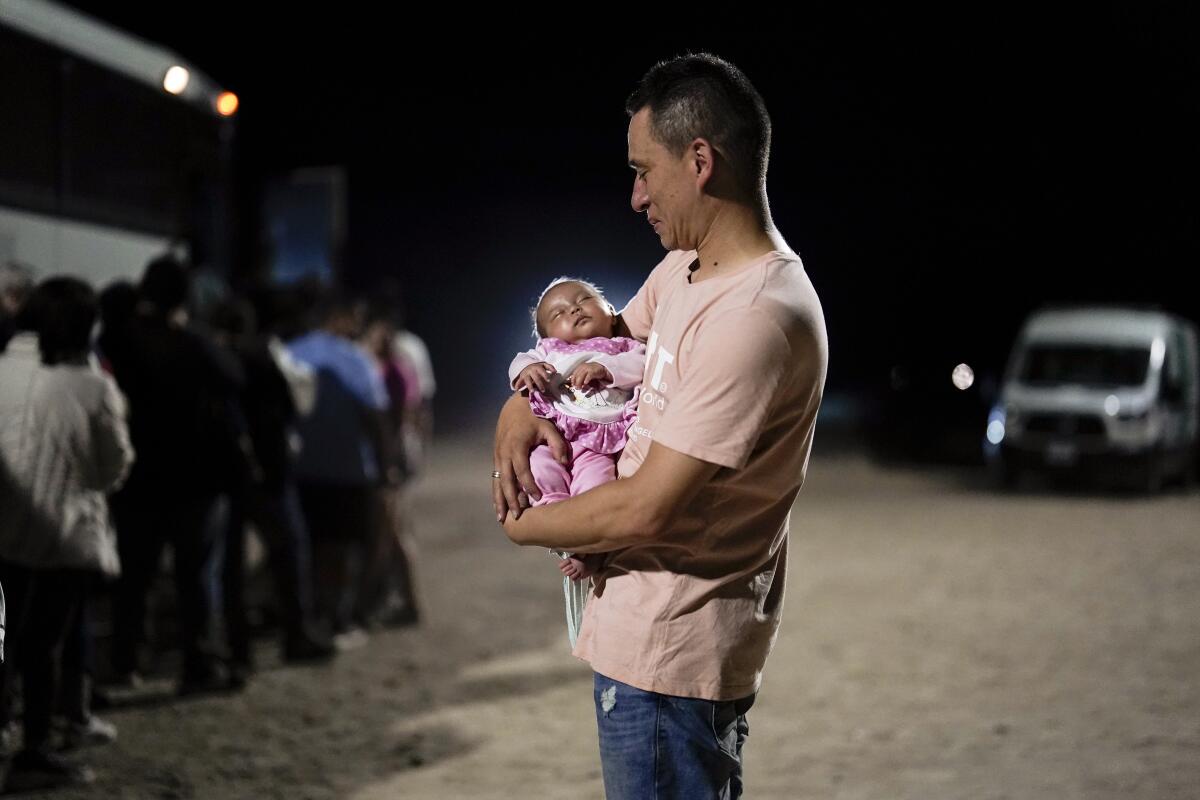Stacked shipping containers are no hindrance for migrants crossing the Arizona border

- Share via
YUMA, Ariz. — Hours before Arizona Gov. Doug Ducey declared “a major step forward to secure our border” with the installation of 130 double-stacked shipping containers, hundreds of migrants found their way around them, belying his claim.
They walked through Native American tribal lands to the edge of a towering wall built during the Trump presidency to surrender to border agents waiting outside the reservation, expecting to be released in the U.S. to pursue asylum.
Families, young parents carrying toddlers, elderly people and others easily waded through the knee-deep Colorado River before dawn Wednesday, many in sandals with shopping bags slung over their shoulders.
The border wall isn’t the hot-button issue it was in 2018, when Congress denied Trump funding for one of his top priorities, prompting the longest government shutdown in U.S. history. But last week’s events in Yuma are a reminder of obstacles that governments, state or federal, face with border barriers: difficulty building on tribal land, most notably in the Tohono O’odham Nation in Arizona, and opposition from landowners, especially in Texas, where, unlike other border states, much property on the frontier is privately owned.
Ducey’s critics have seized on images from Univision network showing two containers that toppled during 11 days of construction for unknown reasons. Gary Restaino, the top federal prosecutor in Arizona, used a bilateral meeting in Mexico City to needle the Republican governor Friday, tweeting, “We’re not dumping a bunch of shipping containers in the desert and calling it a wall to get cheap press.”
Ducey retorted that “we’ve taken matters into our own hands” because, he said, the federal government hasn’t done enough.
Migrants continue to avoid barriers by going around them — in this case, through a five-mile gap in the Cocopah Indian Reservation near Yuma, a desert city of about 100,000 people between San Diego and Phoenix that is a major spot for illegal crossings.
President Biden halted border wall construction his first day in office, leaving billions of dollars of work unfinished but still under contract. Trump worked feverishly in his final months in office to reach more than 450 miles, nearly one-fourth of the entire border.
The Biden administration has made rare exceptions to allow small projects to continue at areas deemed unsafe for people to cross, including four gaps in Yuma. It expects to award a contract for Yuma this fall and take up to 28 months to finish.
When U.S. Customs and Border Protection announced its Yuma plans in July, Ducey said he couldn’t wait. Like fellow Republican Gov. Greg Abbott of Texas, he has sparred with the Democratic administration over immigration policies, often suing and recently offering free bus rides to the East Coast for asylum seekers who are released in the U.S. to pursue their cases.
“Arizona did the job the federal government has failed to do — and we showed them just how quickly and efficiently the border can be made more secure — if you want to,” Ducey said to celebrate installation of the containers, which run the length of 13 football fields in five locations combined.
A string of 44 double-stacked containers ends abruptly in an open desert expanse. Farther north, at the Morelos Dam, containers plug several openings in an area that had become less traveled in recent months.
The day Ducey declared his project complete, the Border Patrol encountered a fairly typical count of about 850 migrants entering the country illegally in its Yuma sector. Most were dropped off by bus or hired vehicle on the Mexican side and walked through the reservation in darkness under a crescent moon.
Migrants followed vehicle barriers and dirt roads and used the flashlights on their phones to guide them to Border Patrol agents outside tribal lands to be taken into custody.
Customs and Border Protection hasn’t commented on Ducey’s containers but says its plan to plug gaps in the barrier of steel poles topped with a metal plate up to 30 feet tall will make a difference by funneling traffic to fewer areas.
“If Yuma has 10 gaps and people were crossing all 10 gaps, it’s much more difficult for us to deal with than if Yuma has one or two gaps and the majority of traffic is crossing through those gaps,” said John Modlin, chief of the Border Patrol’s Tucson sector.
Asked for comment, the Cocopah Indian Tribe referred to a May 2020 letter to Customs and Border Protection expressing strong opposition to a wall, saying it would cut access to the river and tribal members in Mexico.
The tribe also released video showing its interim police chief, Arlene Martinez, outlining other cooperative measures with the Border Patrol, such as surveillance cameras and ground sensors. “Cocopah supports efforts to secure the border and always has,” she said.
More to Read
Sign up for Essential California
The most important California stories and recommendations in your inbox every morning.
You may occasionally receive promotional content from the Los Angeles Times.










